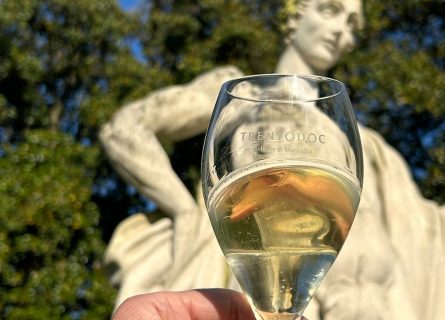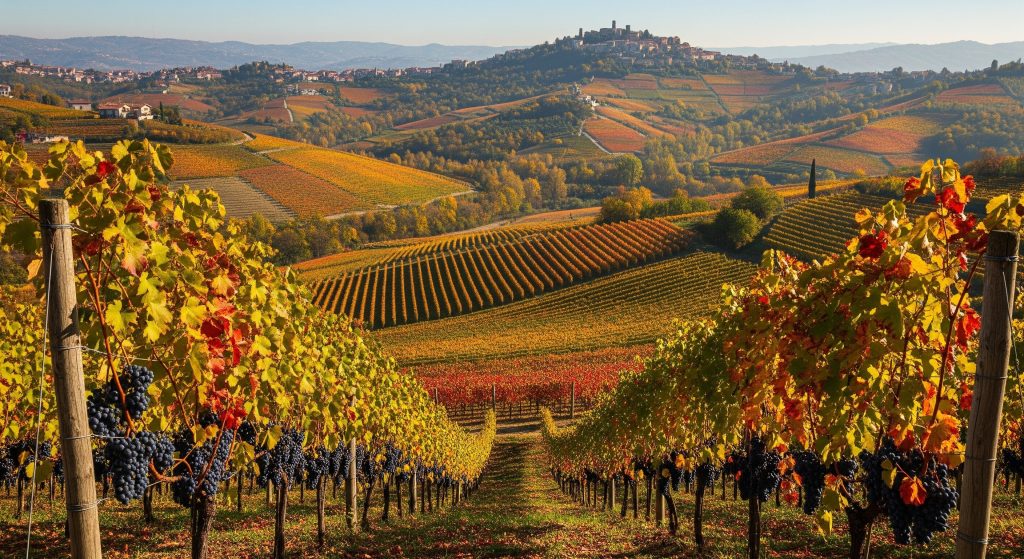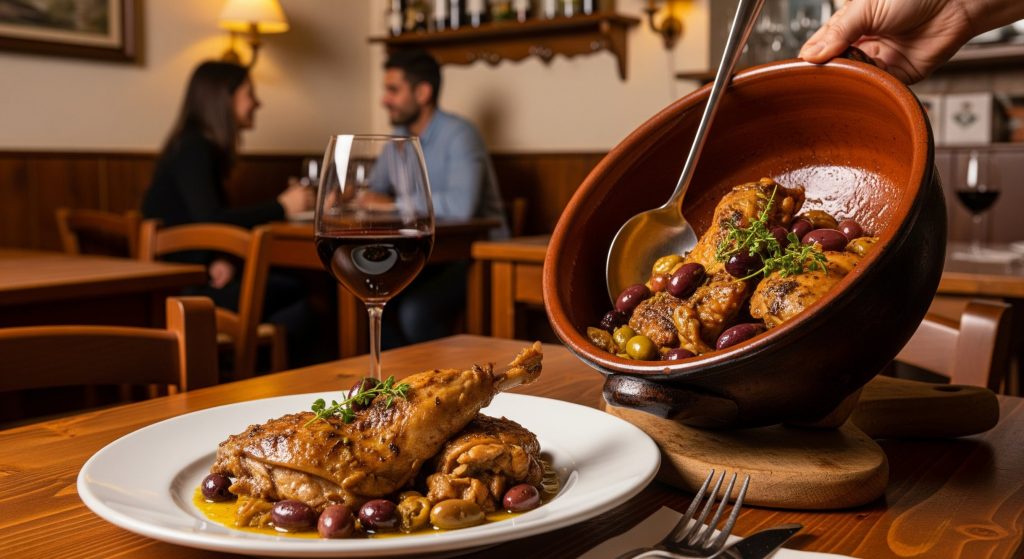
Trentodoc Sparkling Wines: Italy’s Mountain Metodo Classico
June 5, 2025
Explore the unique qualities of Trentodoc sparkling wines, known for their elegance, precision, and freshness. Discover why they stand out.
Federico Ceretto’s story reflects a deeper tension shaping Piedmont’s identity. The Ceretto family, alongside the Gaja family, were among the first to transform Barolo and Barbaresco from local wines into internationally recognized symbols of prestige, pioneering a new marketing model that helped position the Langhe on the global wine map.

Federico Ceretto, reflecting on the legacy of Dolcetto in his family.
“It was a bit of an obsession for my grandfather; he made five different Dolcetto, ranging from a simple table wine to a lightly sparkling version, all from its most prized parcel: ten hectares of Rossana, the hill that overlooks Alba, the heart of Langhe wine making. But my father Bruno and my uncle Marcello understood that Nebbiolo would be the future – and, really, the fortune – of our region. Still, I’ve come full circle. I love Dolcetto. I bring it to international tastings, wearing a T-shirt that says: Make Dolcetto Great Again”.
For much of its history, winemaking here wasn’t a specialized craft set apart from other activities: it was one part of agricultural life. Families made wine for their own tables – straightforward and unpretentious – and only gradually, over the 20th century, certain wines began to break away and find value on the international market.
In Piedmont, we then had, on one side, the rise of prestige wines – notably Barolo – meant for aging and export; on the other, the persistence of native varieties, tied to local culture and everyday consumption. This division wasn’t just between grapes or styles, but between purposes: wines to sell, and wines to drink.
And even now that Barolo and Barbaresco are global icons, that underlying tension hasn’t disappeared. If anything, it has become more interesting because the wines that once stayed in the shadows are now stepping forward. Over the past decade or so, wine insiders have turned their attention to what is often called “the other Nebbiolo” – the elegant expressions produced in the Alto Piemonte, in appellations such as Gattinara, Ghemme, Boca, and Lessona.
What comes next? I’d wager that the next ten years in Piedmontese wine will not belong to Nebbiolo, but rather to Piedmont’s “other reds”. Dolcetto, Freisa, Grignolino, and Ruchè may not yet be household names, but they’re already winning over those with a taste for rarity and originality.
Dolcetto is often described as Piedmont’s everyday wine. For generations, it truly was. Until not long ago, it was the most widely planted grape across a vast stretch of northwestern Italy – from the Ligurian coast to the foothills of the Monviso. The southernmost denomination, Dolcetto di Ovada, is in Liguria; from there it sweeps through the Langhe and up toward Saluzzo, where vines clung to the base of the Alps— Pied d’ mont, “foot of the mountain”, quite literally. This was the wine poured into carafes at trattorie across the region. There were no bubbles, no whites; Barbera was riper and rounder, mostly made in the warmer Astigiano. Nebbiolo was noble. Dolcetto was what people drank.
Its name – “little sweet one” – has contributed to confusion. Some say it refers to the grape’s soft acidity and plush fruit; others to the dolci colline, the gently rolling hills where it’s grown. Either way, many still assume it’s a sweet wine, which it is not. It’s intensely ruby in color, low in alcohol, with noble tannins and a structure that speaks clearly of the Langhe.
In today’s restaurants and wine lists, Dolcetto is finding a new role. Federico Ceretto jokes about his Make Dolcetto Great Again campaign – but it’s not just sentiment. All the great names of the Langhe still produce Dolcetto, including Giacosa, Sandrone, Gaja, Burlotto, Pio Cesare, and Mascarello.
There may be no other place in the world where top-tier producers unanimously commit to crafting a daily wine. The best vineyards have been preserved, and today, you can drink a Dolcetto from a legendary cellar at the price of a Gamay, its genetic cousin.
As Ceretto puts it,
“You want to drink Mascarello every day? Thanks to Dolcetto, you can.”
Genetically linked to Nebbiolo, Freisa is perhaps its most unruly relative. It shares the parent grape’s noble tannins and aromatic lift, but layers them with an earthy, untamed energy. Historically, Freisa was often made in a slightly frizzante or off-dry style, partly to tame its natural bitterness and partly because local tastes demanded it. But today’s best examples are dry, still, and utterly captivating.
Producers like Giuseppe Mascarello and G.D. Vajra have reimagined Freisa as a serious red wine, capable of aging and worthy of contemplation. Its nose offers an array of dried herbs, sour cherry, rose petals, and cracked pepper. On the palate, it’s both rustic and refined – tight-knit in its youth, but increasingly harmonious with time.
Freisa thrives in the hills around Turin and parts of the Monferrato, where the climate and soils help preserve its acidity and aromatic range. For collectors, it offers something few wines can: a sense of place, a streak of eccentricity, and the thrill of discovering a hidden lineage.
Grignolino’s name likely derives from grignòle, the Piedmontese dialect term for grape seeds, of which this variety has an unusually high quantity. These tannin-rich seeds make it notoriously difficult to vinify with finesse.
In addition to this, its pale color – almost rosé – was long viewed with suspicion in rural Italy, where innkeepers often diluted wines with water to stretch the supply and therefore darker wines were associated with strength and quality (this mindset has done real damage to Italian wine culture, including – at times – fostering fraud, but this is for another time).
Grignolino, when made well, is anything but weak: high in both acidity and tannin, it requires real sensitivity in the vineyard and restraint in the cellar. Its aromas are white pepper, dried rosé, wild strawberry, hints of sandalwood, and mint. The best examples come from the sandy soils of the Monferrato, where it was once considered the wine of the Savoy aristocracy.
Braida and Castello di Neive are among the few producers who continue to champion Grignolino with conviction. Their wines are lean, precise, and beautifully aromatic – closer in spirit to Burgundy than to most Italian reds (and on a day like today, under the grip of a summer heat wave, it’s the one on this list I most feel like drinking).
Of all Piedmont’s lesser-known reds, Ruchè may have the most miraculous return story. By the mid-20th century, it was on the verge of extinction until a parish priest, Don Giacomo Cauda, began tending a forgotten vineyard behind his church in Castagnole Monferrato in the 1960s. Recognizing the grape’s potential, he vinified it with care and generosity, effectively relaunching a wine that would go on to find amazing success.
Ruchè is instantly recognizable thanks to its beautifully floral bouquet, featuring damask rose, violet, and geranium, along with ripe red fruit, sweet spice, and a delicate note of white pepper. On the palate, it’s medium-bodied but lush, with soft tannins and a perfumed finish.
Montalbera and Ferraris Agricola have played a crucial role in elevating Ruchè to international recognition. Their wines are featured on Michelin-starred wine lists and are highly regarded by sommeliers.
For collectors, Ruchè offers not just novelty but real substance. With only a few hundred hectares, it remains one of the most limited and distinctive expressions of Piedmontese terroir.
Each of these grapes thrives in a distinct corner of Piedmont. Dolcetto prefers the calcareous clay of Dogliani and Diano d’Alba, where its fruit gains depth and structure. Freisa is most expressive on the marl and limestone slopes of the Collina Torinese and Monferrato Astigiano. Grignolino’s delicacy is best preserved on the sandy soils of Asti and Casale Monferrato, while Ruchè owes its aromatic intensity to the warm, well-drained hills around Castagnole Monferrato.

Pairing these wines is a pleasure and an extension of their character. Dolcetto’s freshness and bitter edge pair effortlessly with Piemontese classics, such as tajarin with butter and sage, or slow-braised rabbit with olives and herbs. Freisa’s structure stands up to game, roasted duck, or aged mountain cheeses. Grignolino is great with battuta all’albese (veal tartare), mushrooms, and delicate vegetable dishes. Ruchè, with its exotic perfume, pairs surprisingly well with Middle Eastern and Asian dishes.
There are several reasons why these wines are gaining traction among collectors and connoisseurs:
The first being scarcity. With limited vineyard areas and artisanal production methods, many of these wines are produced in small quantities—sometimes just a few hundred cases per year —and often have limited international distribution.
Then there’s distinctiveness: in a global market increasingly crowded with homogenized reds, these wines stand apart. Unique flavors, even more unique stories. They also age well, not always in the same way as Barolo, but with grace and integrity.
Third, “discovering” new wines (although, just like America, it’s never a discovery to begin with!) is always exciting: to collect these wines is to be part of a movement, a region reclaiming its hidden treasures.
But – in the hope of not sounding too preachy – I’d like to add that there’s an ethical dimension. Concentrating too much attention – and money – on just a few well-known appellations can have negative consequences. In places where a hectare of vineyard costs millions of euros, pressure inevitably mounts to plant more vines, often at the expense of forests and biodiversity.
By exploring lesser-known areas, we can make a direct contribution to the vitality of rural communities. In Italy, and especially in Piedmont, this dynamic is increasingly evident.
In the 1960s, Piedmont experienced a significant surge in internal migration, as industrial jobs became available in cities like Turin and Ivrea, leading to the depopulation of rural towns. People left farming behind to work for companies like Fiat and Olivetti. When deindustrialization occurred, those areas were left in a state of limbo, neither industrial nor agricultural.
And yet, wine can contribute to a reversal. In Boca, the rediscovery of Nebbiolo has brought new energy to a village once in decline. In Caluso, the rise of Erbaluce has given young growers a reason to stay and invest in the area. And it can happen again – in Monferrato, in Castagnole Monferrato, in the hills around Dogliani – if curiosity replaces habit, and diversity becomes a part of how we define value.
In this sense, to collect Piedmont’s other reds isn’t just a gesture of personal taste. It’s a small act of stewardship – a way of keeping alive the full richness of a region that has more to say than even Barolo can contain.
If you would like us to customize an exclusive luxury tour, contact us and let us know your travel plans. We offer luxury food and wine tours for private groups of a minimum two guests. In addition, all of our private, chauffeured tours are available year-round upon request.

